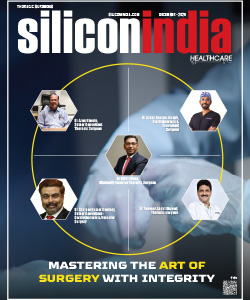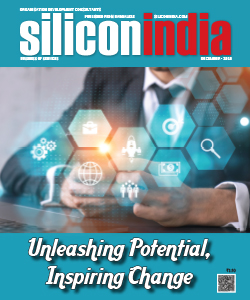Digital transformation: A multidisciplinary reflection and its different stages

Digital transformation is crucial for all businesses, from the small to the enterprise. The world has witnessed that today's organizations are in different places on the road to digital transformation. In a recent interaction with the Editor of Siliconindia, SharathSrinivasamurthy, Research Director, Enterprise Solutions & ICT Practice, IDC India, shared his insights on how technology is helping businesses stay relevant and required skills on the same.
As an Industry expert, what does digital transformation mean to you? And how is technology helping businesses stay relevant?
IDC defines digital transformation as transforming decision making with technology. Digital transformation is about transforming businesses by leveraging technologies which otherwise was not possible or taken more time. It is about building new business models, developing new products/services, delivering better experiences to all stakeholders, and running operations in a more efficient way resulting in better top-line or bottom-line or both. In many cases, digital transformation helps businesses stay relevant.Digital transformation is a journey and not the destination. In this journey, multiple technologies can be leveraged which can add value.
As businesses go through their digital transformation journey, there is an increasing need for software and hardware to be made available on-demand. Cloud is helping business to innovate and go to market faster by leveraging advanced cloud-native features and pay for what is used for. Also, the reduction capex can be diverted towards innovation. Businesseshave a lot of data and need for making sense of data is important. Big data and analytics are helping enterprises to analyze their customer and operational data to drive targeted campaigns, develop new products and services and optimize operations. RPA is helping enterprises automate a lot of manual tasks and keep operations going even when employees were not physically present in office. AI and ML based solutions are helping businesses take intelligent decisions. Hospitals have adopted telemedicine and robotics redefine patient care. Many businesses have leveraged AI/ML solutions for recommending complementary products to users based on consumer demographics, sales, product, and financial information. Video-KYC and automated customer agents (chatbots) have become one of the popular use cases in BFSI segment. Manufacturing firms are leveraging digital technologies to predict demand, reduce time to market, and right size their inventory across the supply chain. Businesses are leveraging automated document processing solutions to digitize documents and process them at scale. The AI-enabled automation resulted in cutting down middle- and back-office work across industries. Businesses are leveraging AIOps to streamline and automate IT operations not only to reduce manual and repetitive tasks but also prevent incidents that might have serious business impacts. Cybersecurity analytics, intelligence, response, and orchestration (AIRO) is helping business prevent and remediate cyber threats. Low-code/no-code platforms are helping business users develop and deploy applications reducing dependency on IT teams helping them go to market faster.
What skills are a "must have" in order to achieve your digital transformation objectives?
Leadership, direction and communication: Top leadership has an important role to play in achieving digital transformation objectives. Leadership buy-in, articulation of digital strategy and vision to the organization, communicating the benefits on an ongoing basis and change management play an important role in cementing digital-fist mindset across the organization
Culture of innovation and agility: Culture of agile needs to be driven top-down from strategy creation to the development of an application feature to ticket handling in operation. Businesses need to be agile in trying new products, services and keep improvising. Iteration is a core principle in the agile at all activity layers.
Design thinking: Traditional approaches to application, product, service, and experience development focus on technical feasibility and business viability, but they often don't create applications, products, and services that are compelling and desirable enough to encourage uptake and usage. Design thinking is a human-centric approach to problem solving that strives to balance feasibility and desirability to ensure the creation of desirable products and services that will create demand. Look at every problem from customer's angle and work on solutions to solve them.
Business process reengineering: At the end of the day, the success of digital transformation initiatives depends on the underlying business processes. Analyzing existing processes and reengineering them before technology intervention is essential.
Get a good handle of data:Eliminate data silos. Have a data strategy in place that help identify issues and help in informed decision making
How does digital transformation take shape in an organization and is gradually reflected in multiple facets of the firm's business?
Digital transformation is a journey and takes shape in the organization in a gradual manner as below.
- Build a digital strategy platform:
- Build digital strategy and operational plans with a strategy platform combining enterprise performance management (EPM), application portfolio management (APM), and program/project management methods to identify pain pointsin real time
- Estimate spending on digital transformation and costs of supporting legacy systems and to track the ROI on digital investments.
- Redesign business and IT operational processes
- Examine service request touch points and expansion of self-service.
- Redesign business and IT operational processes
- Leverage RPA to shorten process execution by automating repetitive manual processes
- Encapsulate common parts of redefined processes for reuse using APIs, containers, and microservices
- Explore experiential design
- Overhaul and radically improve customer and employee experience through personalization fed by data analytics and customer intelligence.
- Consider the insertion of conversational platforms to provide a more engaging interface
- Reimagine enterprise architecture
- Periodically perform application rationalization
- Reimagine legacy processing platforms to create connected digital ecosystems using cloud implementations
- Discourage development of new capabilities on legacy platforms.
- Add focus to a data platform that supports aggressive analytics
- Evaluate and evolve development approaches
- Increase the use of low-code or no-code capability development, externally available code libraries, and Agile/DevOps methodologies.
- Business model disruption
- Design products based on data collected during the active life of products
- Use the success metrics and data collected for analyzing the competition devise methods to reduce the barrier to entry to new market segments
What role does customer value play in this digital transformation led shift toward sustainable and regenerative business?
A successful enterprise will deliver hyper-personalized experiences for their customerswith real-time contextual relevancy. Enterprises anticipate and intercept customer needs using predictive analytics to drive automated next-bestactions using offers of real-time delivery of products and services.Successful enterprises will have intimate omni-channel knowledge of customer preferences andbehavior by leveraging first-party data provided by the customer by choice to their trusted brands. Customer value is delivered through meaningful conversations, memorable journeys and eventually customer satisfaction. When there is customer value being generated, there is a clear exchange ofinformation, knowledge, and understanding leading to mutual trust. Businesses must strive to be a brand that can partner with customers on their journeys andwhere customers reciprocate with a desire to engage and with their loyalty leading to sustainable and regenerative business.
Given the complexity of digital transformations, how can we simplify the process?
Businesses need to realize that Digital Transformation is not a one-time activity but is a journey. Some of the recommendations to simplify the process are:
- Map and refinecustomer journeys to drive Customer Experience: Map all journeys that customer could potentially take while they interact with your business. Identify the pain points where the journey/experience could fail and fix them
- Start small: While digital transformation strategy is driven top-down, it is advisable to pick-up the low hanging fruits to test your strategy, skills and execution capability. The successes of these initiatives should be comminated to all stakeholder so that the larger organization gains confidence on the strategy. Starting small also helps in doing course corrections and learning which will help deliver digital transformation at scale in future
- Develop a culture of Agility: Build a culture if agility across all functions in the organizations.
- Eliminate data silos to leverage insights to drive innovation and efficiencies: Getting a unified view of data makes decision making a lot easier; be it business data or operational data.
- Have the right KPIs to measure and it them to business outcomes: Business need to relook at how they measure the effectiveness of their IT teams and investments. They need to tie IT initiatives to business outcomes.
- Keep pace with changing technology: It is always critical to keep abreast with new technology advancements and have a separate division that keeps experimenting on new technologies

.jpg)


.jpg)
.jpg)